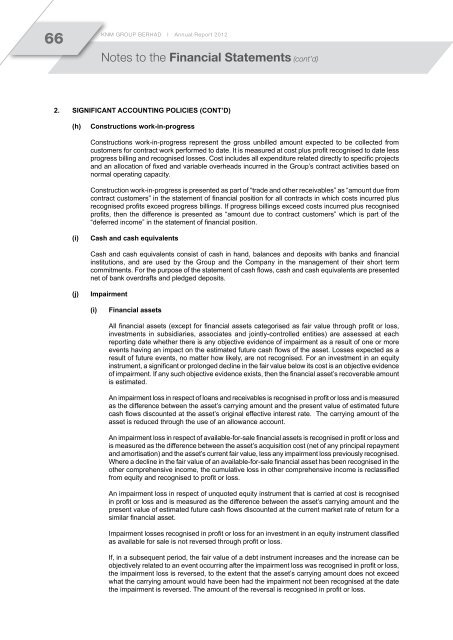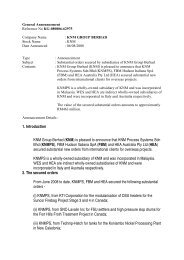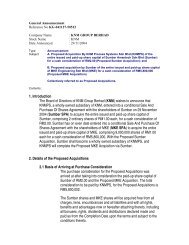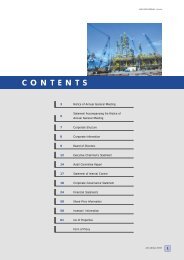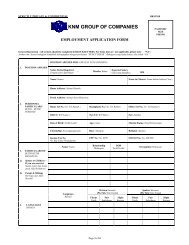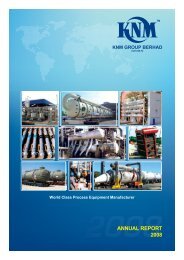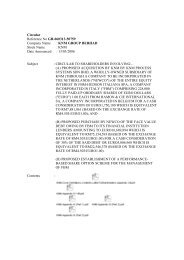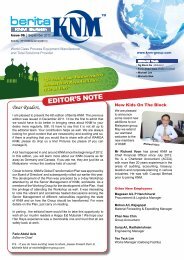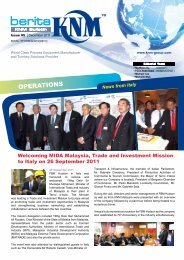cont'd - KNM Steel Sdn Bhd
cont'd - KNM Steel Sdn Bhd
cont'd - KNM Steel Sdn Bhd
- No tags were found...
You also want an ePaper? Increase the reach of your titles
YUMPU automatically turns print PDFs into web optimized ePapers that Google loves.
66<strong>KNM</strong> GROUP BERHAD I Annual Report 2012Notes to the Financial Statements (cont’d)2. Significant accounting policies (Cont’d)(h)Constructions work-in-progressConstructions work-in-progress represent the gross unbilled amount expected to be collected fromcustomers for contract work performed to date. It is measured at cost plus profit recognised to date lessprogress billing and recognised losses. Cost includes all expenditure related directly to specific projectsand an allocation of fixed and variable overheads incurred in the Group’s contract activities based onnormal operating capacity.Construction work-in-progress is presented as part of “trade and other receivables” as “amount due fromcontract customers” in the statement of financial position for all contracts in which costs incurred plusrecognised profits exceed progress billings. If progress billings exceed costs incurred plus recognisedprofits, then the difference is presented as “amount due to contract customers” which is part of the“deferred income” in the statement of financial position.(i)Cash and cash equivalentsCash and cash equivalents consist of cash in hand, balances and deposits with banks and financialinstitutions, and are used by the Group and the Company in the management of their short termcommitments. For the purpose of the statement of cash flows, cash and cash equivalents are presentednet of bank overdrafts and pledged deposits.(j)Impairment(i)Financial assetsAll financial assets (except for financial assets categorised as fair value through profit or loss,investments in subsidiaries, associates and jointly-controlled entities) are assessed at eachreporting date whether there is any objective evidence of impairment as a result of one or moreevents having an impact on the estimated future cash flows of the asset. Losses expected as aresult of future events, no matter how likely, are not recognised. For an investment in an equityinstrument, a significant or prolonged decline in the fair value below its cost is an objective evidenceof impairment. If any such objective evidence exists, then the financial asset’s recoverable amountis estimated.An impairment loss in respect of loans and receivables is recognised in profit or loss and is measuredas the difference between the asset’s carrying amount and the present value of estimated futurecash flows discounted at the asset’s original effective interest rate. The carrying amount of theasset is reduced through the use of an allowance account.An impairment loss in respect of available-for-sale financial assets is recognised in profit or loss andis measured as the difference between the asset’s acquisition cost (net of any principal repaymentand amortisation) and the asset’s current fair value, less any impairment loss previously recognised.Where a decline in the fair value of an available-for-sale financial asset has been recognised in theother comprehensive income, the cumulative loss in other comprehensive income is reclassifiedfrom equity and recognised to profit or loss.An impairment loss in respect of unquoted equity instrument that is carried at cost is recognisedin profit or loss and is measured as the difference between the asset’s carrying amount and thepresent value of estimated future cash flows discounted at the current market rate of return for asimilar financial asset.Impairment losses recognised in profit or loss for an investment in an equity instrument classifiedas available for sale is not reversed through profit or loss.If, in a subsequent period, the fair value of a debt instrument increases and the increase can beobjectively related to an event occurring after the impairment loss was recognised in profit or loss,the impairment loss is reversed, to the extent that the asset’s carrying amount does not exceedwhat the carrying amount would have been had the impairment not been recognised at the datethe impairment is reversed. The amount of the reversal is recognised in profit or loss.


